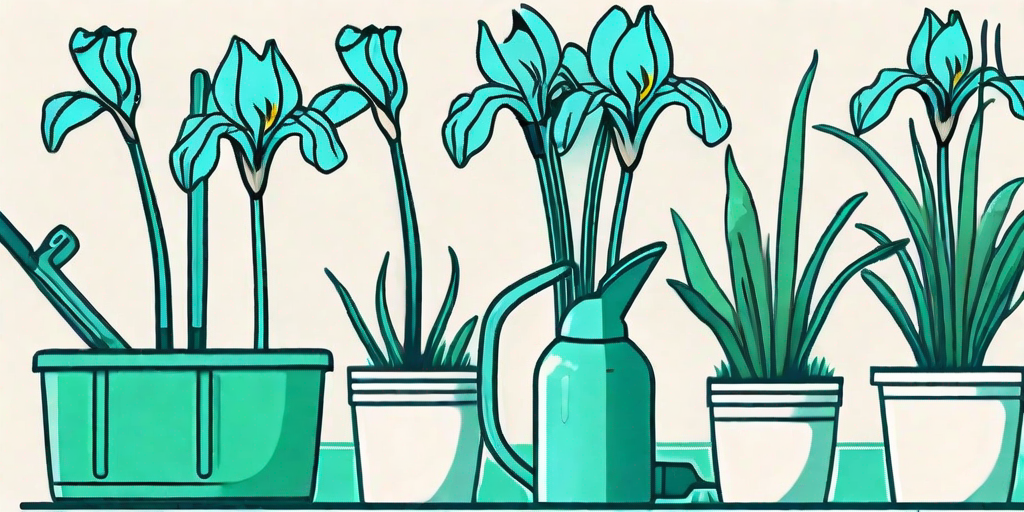
Welcome, green-thumbed enthusiasts and flower aficionados! If you're here, it means you're on a mission to keep your irises blooming like a fireworks display on the Fourth of July. Fear not, for you've come to the right place. This guide will arm you with all the secrets you need to ensure your irises are the envy of the neighborhood. So, buckle up and let's dive into the wonderful world of iris care.
Understanding Your Irises
The Iris Family
First things first, let's get to know the star of our show a little better. Irises, not to be confused with the part of your eye or that Goo Goo Dolls song, are a genus of 260-300 species of flowering plants with showy flowers. They're like the Kardashians of the plant world, but with less drama and more photosynthesis.
Irises come in a variety of shapes and sizes, from the petite dwarf irises that barely reach your ankles to the towering bearded irises that can look you in the eye. And let's not forget about the Siberian and Japanese irises, which are as exotic and beautiful as their names suggest.
What Irises Need
Like any diva, irises have their demands. They're not too fussy, but they do enjoy a bit of pampering. Sunlight, well-drained soil, and a good haircut (pruning) are the keys to keeping your irises happy and healthy.
Irises love the sun. They need at least six hours of direct sunlight each day. So, if your garden is more shaded than a vampire's lair, irises might not be the best choice for you. But if your garden is sunnier than a Californian beach, your irises will be basking in the glory.
How to Care for Your Irises
Planting Your Irises
Planting irises is as easy as pie. And by that, I mean it's as easy as eating pie, not baking it. Baking pie is hard. Anyway, here's a simple step-by-step guide:
- Choose a sunny spot in your garden.
- Prepare the soil by adding compost and ensuring good drainage.
- Plant the iris rhizomes (that's fancy talk for bulbs) about one to two inches deep and two feet apart.
- Water thoroughly.
Voila! You've just planted your irises. Now, all you have to do is wait for them to grow and start blooming like a pop star's career.
Feeding Your Irises
Irises aren't big eaters, but they do appreciate a good meal. A balanced fertilizer applied in early spring and again in late summer will keep your irises well-fed and ready to bloom.
But remember, too much of a good thing can be bad. Over-fertilizing can lead to soft, lush growth that's more susceptible to disease. So, go easy on the fertilizer. Your irises aren't trying to win a weightlifting competition.
Pruning Your Irises
Pruning is like giving your irises a haircut. It helps them look their best and promotes healthier growth. Here's how to do it:
- Remove any dead or damaged leaves.
- Cut back the leaves to about six inches in the fall.
- Remove the spent flower stalks to prevent seed formation.
And there you have it. A well-pruned iris is a happy iris. And a happy iris is a blooming iris.
Common Iris Problems and How to Solve Them
Bacterial Soft Rot
Bacterial soft rot is like the common cold for irises. It's caused by bacteria that thrive in wet conditions. The symptoms include soft, mushy rhizomes and a foul smell. Think of it as iris halitosis.
The solution? Good hygiene and proper watering. Avoid over-watering and make sure your irises are planted in well-drained soil. If you notice any signs of soft rot, remove the affected parts and treat the plant with a fungicide.
Iris Borer
The iris borer is a pesky little critter that can wreak havoc on your irises. The larvae burrow into the rhizomes and feed on the plant tissue, causing significant damage.
The best defense is a good offense. Keep an eye out for any signs of damage and act quickly. Remove and destroy any affected plants and apply an appropriate insecticide.
Frequently Asked Questions
When is the best time to plant irises?
The best time to plant irises is in the late summer or early fall. This gives the plants enough time to establish themselves before the winter.
How often should I water my irises?
Irises don't like to have wet feet. Water them thoroughly at planting time and then only when the soil is dry to the touch.
Why aren't my irises blooming?
There could be several reasons why your irises aren't blooming. They might not be getting enough sunlight, they could be overcrowded, or they might not be getting enough nutrients. Check these factors and adjust as necessary.
And there you have it, folks! A comprehensive, fun, and slightly cheeky guide to keeping your irises blooming. Now, go forth and let your irises shine!















